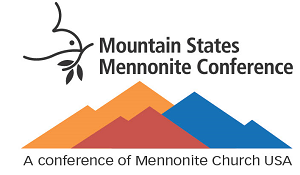I had the privilege of participating in the Mennonite Mission Network’s annual conference for church planters. We met at Living Water Community Church (LWCC) in Roger’s Park, on the north side of Chicago. The location is just west of Loyola University (on the lake), a beautiful old neighborhood, full of trees, apartment blocks, Victorian-style houses, and train tracks running through it, with intentional and non-intentional graffiti art along the tracks and in the overpasses. LWCC is on a corner where there was a fatal gang-related shooting some twenty years ago. A group from Reba Place Church came and prayed there, and it came to be that a new church developed from that act of prayer and solidarity in the neighborhood.
The church is now home to five language groups: Kiswali, Nepali, Kirundi, Khmer/Cambodian, and English. Each groups is of an ethnicity in the neighborhood. They meet both together and separately for worship and fellowship, and share in a transformative mission in the Roger’s Park neighborhood.
Our gathering was comprised of folks who had started or were exploring starting new faith communities. Many participants’ first language was Spanish. Faith communities had been started in a great diversity of settings but all with a sense that Christ-formed community mattered in ways that were very important to us all.
This gathering celebrated all kinds of new starts and initiatives. The theme had to do with how legacy churches (existing, usually long-standing churches) can assist and relate to new church starts. There was a sense that legacy churches often greatly benefit from new church starts and may even see new life themselves from the new activity around them.
On Sunday morning, we were part of a powerful, multi-lingual service. The Bible was read in three languages. Gathered were people of many colors, races, ethnicities. The “Unity Choir,” young adult African women, primarily, sang. There was drumming that started softly and then became stronger. The women called out some notes. A jazz guitarist began to lay down some riffs and chords. Soon, a soloist or two sang out a verse. And then the whole choir joined in flowing, joyous harmony.
We were dancing, all ethnicities, all languages, together around the worship space. People were smiling, moving, singing. It was an ecstatic moment. I think of this now when I think about my answer to the question: “Why do we go to church?” It is for such ecstasies as this. Ecstasy, as the old preaching point goes, comes from the words in Greek that mean to stand outside of ourselves. We were standing outside of ourselves with “the other” in a moment of joy.
I came away feeling like everything was all right. I felt healing, hope. It was the City of God in that moment. That’s church that matters.
Vern Rempel
I did not grow up in the Mennonite tradition. Now, as a Mennonite pastor, I often ask myself, “What does it mean to be a Mennonite.” What have I been re-baptized into? What have I been re-baptized out of?
The saying goes, “If you’ve been to one Mennonite church, you’ve been to one Mennonite church.” Mennonite identity in worship settings is amorphous and fluid, and it differs from place to place. Vern’s description of the 2018 Sent conference as diverse and multi-lingual is spot on. It was a beautiful representation of all God’s people. Noticeably absent, however, at least from the perspective of this outsider, was anything that betrayed a cultural Mennonite identity. There were no blue hymnals in sight, no four part harmonies. No one even asked me my last name or tried to play the Mennonite game. Instead, the conference seemed to seek a theological commonality, a commonality centered on the idea of a Peace Church.
I skipped worship with LWCC. Having gone to seminary in Chicago, I chose instead to visit friends at Chicago Community Mennonite Church. There was a marked difference between these two communities. There were blue hymnals, four part harmonies, and I even met people who knew Steve and Susan Goering when they were at Boulder (the first time I’ve been able to play the Mennonite game). CCMC had several hallmarks of Mennonite culture. It is also predominantly Anglo. This is, of course, not to say that CCMC isn’t doing wonderful things. They are doing wonderful things, but for someone who’s consistently asking, “What does it mean to be a Mennonite,” I couldn’t help but notice the difference.
I’d like to draw a general lesson from this experience, rather than a specific one, in part because I love the blue hymnal and four-part harmony. The Sent conference invited me to think about how our theological values might be the glue that binds us, how the promotion of peace and justice might be our truest identity. It would not be true to say that my theology aligned perfectly, or even very well at times, with all those at the conference or the conference organizers. In fact, my theology aligns much more with that of CCMC. As we look into the near future, however, what do we see? More people who’ve learned their part in four-part harmony or more people working for peace and justice? More Mennonites or more people conformed to a cruciform way of living?
Zach Martinez
